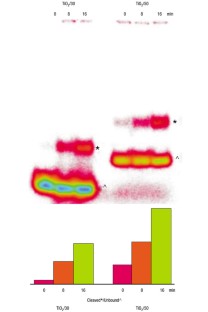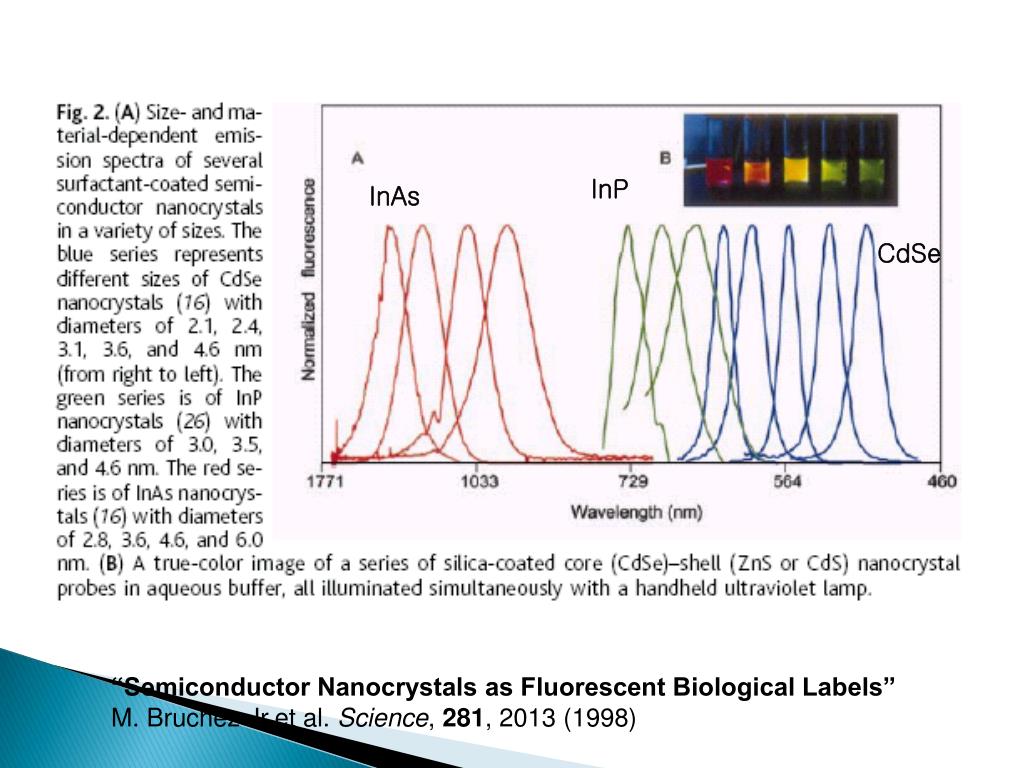45 semiconductor nanocrystals as fluorescent biological labels
Semiconductor nanocrystals as fluorescent biological labels Semiconductor quantum rods as single molecule fluorescent biological labels. Nano Letters 7(1): 179-182, 2007. Semiconductor fluorescent nanocrystals (quantum dots) in biological biochips. Bioorganicheskaia Khimiia 37(2): 171-189, 2011. Bioconjugated fluorescent zeolite L nanocrystals as labels in protein microarrays. Small 7(22): 3193-3201, 2011 PDF Ovid: Bruchez: Science, Volume 281(5385).September 25 ... - ResearchGate Semiconductor nanocrystals were prepared for use as fluorescent probes inbiological staining and diagnostics.Compared with conventional fluorophores, thenanocrystals have a narrow,
3C-SiC Nanocrystals as Fluorescent Biological Labels Abstract. Silicon carbide nanocrystals are water-soluble, chemically inert, and highly fluorescent, and they may be idealas biological labels. After the uptake of3C-SiC nanocrystals, human fetal osteoblast (hFOB) cells exhibit brightgreen-yellow fluorescence (see image).The nanoparticles show high resistanceagainst photobleaching with no significant cytotoxicity.
Semiconductor nanocrystals as fluorescent biological labels
3C-SiC Nanocrystals as Fluorescent Biological Labels Silicon carbide nanocrystals are water-soluble, chemically inert, and highly fluorescent, and they may be idealas biological labels. After the uptake of3C-SiC nanocrystals, human fetal osteoblast (hFOB) cells exhibit brightgreen-yellow fluorescence (see image).The nanoparticles show high resistanceagainst photobleaching with no significant cytotoxicity. A novel fluorescent label based on biological fluorescent nanoparticles ... Uniform-sized fluorescent nanoparticles have been prepared by employing silica as the shell and a highly luminescent dye complex of ruthenium ion and bipyridyl, tris(2,2'-bipyridyl) dichlororuthenium(II) hexahydrate as the core of the nanoparticles. A novel fluorescent label method is proposed, which is based on the biological fluorescent nanoparticles on the foundation of nanotechnology ... Quantum Dot - an overview | ScienceDirect Topics Rubi Mahato, in Emerging Nanotechnologies for Diagnostics, Drug Delivery and Medical Devices, 2017. 2.3.1 Quantum Dots. QDs are colloidal fluorescent semiconductor nanocrystals (2–10 nm) with narrow emission and a broad range of absorption bands.This material is predominantly used in fabricating imaging probes [68].The central core of QDs consists of combinations of …
Semiconductor nanocrystals as fluorescent biological labels. Semiconductor nanocrystals as fluorescent biological labels. - Abstract ... Semiconductor nanocrystals were prepared for use as fluorescent probes in biological staining and diagnostics. Compared with conventional fluorophores, the nanocrystals have a narrow, tunable, symmetric emission spectrum and are photochemically stable. Emergence of colloidal quantum-dot light-emitting technologies Dec 27, 2012 · This Review article summarizes the key advantages of using quantum dots (QDs) as luminophores in light-emitting devices (LEDs) and outlines the operating mechanisms of four types of QD-LED. The ... Semiconductor nanocrystals as fluorescent biological labels Abstract Semiconductor nanocrystals were prepared for use as fluorescent probes in biological staining and diagnostics. Compared with conventional fluorophores, the nanocrystals have a narrow, tunable, symmetric emission spectrum and are ... Semiconductor nanocrystals as fluorescent biological labels. 1998. Shimon Weiss. Download Download PDF. Methods and Applications in Fluorescence - IOPscience Methods and Applications in Fluorescence is an internationally leading journal, which welcomes contributions on the study, application, techniques and instrumentation of fluorescence. These encompass biological, medical, chemical, material and nano research using experimental, theoretical and data analysis methods, which span probes, spectroscopy, imaging and …
Semiconductor Quantum Rods as Single Molecule Fluorescent Biological Labels In this paper, we report the development of rod-shaped semiconductor nanocrystals (quantum rods) as fluorescent biological labels. Water-soluble biocompatible quantum rods have been prepared by surface silanization and applied for nonspecific cell tracking as well as specific cellular targeting. Quantum rods are brighter single molecule probes as compared to quantum dots. › what_are_quantum_dotsWhat are quantum dots? - Nanowerk Quantum dots (QDs) are man-made nanoscale crystals that that can transport electrons. When UV light hits these semiconducting nanoparticles, they can emit light of various colors. These artificial semiconductor nanoparticles that have found applications in composites, solar cells and fluorescent biological labels. What are quantum dots? - Nanowerk Quantum dots (QDs) are man-made nanoscale crystals that that can transport electrons. When UV light hits these semiconducting nanoparticles, they can emit light of various colors. These artificial semiconductor nanoparticles that have found applications in composites, solar cells and fluorescent biological labels. PDF Properties of Fluorescent Semiconductor Nanocrystals and their ... fluorescent semiconductor nanocrystals (a class of quantum dots) for biological labeling. Although some of the photophysical properties of nanocrystals are not fully understood and are still actively investigated, researchers have begun developing bioconjugation schemes and applying such probes to biological assays. Nanocrystals
[Semiconductor fluorescent nanocrystals (quantum dots) in biological ... Polymeric beads optically encoded with organic dyes allow for a limited number of unique codes, whereas the use of semiconductor nanocrystals as fluorescent tags improves the beads multiplexed imaging capabilities, photostability and sensitivity of the biological objects detection. Additionally, an employment in suspension biochips of Frster ... Semiconductor nanocrystals as fluorescent biological labels Semiconductor nanocrystals as fluorescent biological labels Author BRUCHEZ, M. JR 1 2; MORONNE, M 3; GIN, P 3; WEISS, S 4; ALIVISATOS, A. P 1 2 [1] Department of Chemistry, University of California, Berkeley, CA 94720, United States [2] Materials Sciences Division, Lawrence Berkeley National Laboratory (LBNL), 1 Cyclotron Road, Berkeley, CA 94720, United States [3] Life Sciences Division, LBNL ... › pmc › articlesApplications of nanoparticles in biology and medicine - PMC Apr 30, 2004 · Understanding of biological processes on the nanoscale level is a strong driving force behind development of nanotechnology . Out of plethora of size-dependant physical properties available to someone who is interested in the practical side of nanomaterials, optical [ 7 ] and magnetic [ 8 ] effects are the most used for biological applications. Magnetic nanoparticles: preparation, physical properties, and ... Feb 21, 2012 · The main problem in cell imaging using the fluorescent nanoprobes is that the fluorescence signal is easily affected by the background noises caused by the cells, matrix, and the nonspecific scattering lights. ... O'Brien S. et al. Bio-functionalization of monodisperse magnetic nanoparticles and their use as biomolecular labels in a magnetic ...
SpectraDot™ Fluorescent Nanocrystals - Spectra Genetics - GPCR Internalization and Trafficking ...
Semiconductor nanocrystals as fluorescent biological labels. Semiconductor nanocrystals as fluorescent biological labels. Science. 1998; ... Semiconductor nanocrystals were prepared for use as fluorescent probes in biological staining and diagnostics. Compared with conventional fluorophores, the nanocrystals have a narrow, tunable, symmetric emission spectrum and are photochemically stable. The ...
pubs.acs.org › toc › achre4Accounts of Chemical Research | Vol 55, No 3 - ACS Publications This Account describes our recent study on the role of organic spacer cations in modulating the electronic confinements, optical properties, and photoconductivity of bismuth-halide perovskites (BHPs). The fundamental understanding of the photophysical properties discussed here would help design novel BHP materials for efficient optoelectronic devices. View the article.
Luminescent nanomaterials for biological labelling - IOPscience Types of fluorescent labelling agents that are commonly used include conventional classes of organic fluorophores such as fluorescein and cyanine dyes, as well as newer types of inorganic nanoparticles such as QDs, and novel fluorescent latex/silica nanobeads.
PDF Semiconductor Nanocrystals as Fluorescent Biological Labels Semiconductor Nanocrystals as Fluorescent Biological Labels Marcel Bruchez Jr., Mario Moronne, Peter Gin, Shimon Weiss,* A. Paul Alivisatos* Semiconductor nanocrystals were prepared for use as ßuorescent probes in biological staining and diagnostics. Compared with conventional ßuorophores,
PDF Semiconductor Nanocrystals as Fluorescent Biological Labels Semiconductor Nanocrystals as Fluorescent Biological Labels. SCLM origin of these peridotites is the close spatial proximity of mantle with such widely varying extraction ages, when every other geochemical aspect of the peridotites sug- gests they are petrogenetically related (9, 10). These Os isotope data indicate that unusu- ally old depleted mantle is stranded within subduction zones.
The Rise and Future of Discrete Organic–Inorganic Hybrid … May 28, 2022 · Hybrid nanomaterials (HNs), the combination of organic semiconductor ligands attached to nanocrystal semiconductor quantum dots, have applications that span a range of practical fields, including biology, chemistry, medical imaging, and optoelectronics. Specifically, HNs operate as discrete, tunable systems that can perform prompt fluorescence, energy …
Semiconductor Nanocrystals as Fluorescent Biological Labels University of California, Los Angeles Abstract and Figures Semiconductor nanocrystals were prepared for use as fluorescent probes in biological staining and diagnostics. Compared with conventional...
Semiconductor Nanocrystals: The Next Thing in Fluorescent Probes "The development of semiconductor nanocrystals for biological labeling gives biologists an entire new class of fluorescent probes for which no small organic molecule equivalent exists," the authors of the Science paper wrote. "These nanocrystal probes can be complementary and in some cases may be superior to existing fluorophores."






Post a Comment for "45 semiconductor nanocrystals as fluorescent biological labels"